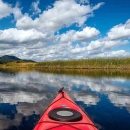We periodically place federal metal leg bands on ducks just prior to hunting season. This information is used to inform harvest regulations. Ducks are captured by baiting sites with cracked corn and placing traps. The species, age, and sex of captured ducks is recorded prior to banding and release. In 2021, 215 Northern Pintail, 211 American Green-winged Teal, 38 Mallard, and 6 American Wigeon were banded. Notably, the first banding of a Blue-winged teal on the Refuge also occurred in 2021. This bird was a young-of-the-year and most likely locally raised. Like other species, such as Ruddy Duck, the breeding range of Blue-winged Teal is probably expanding north. Earlier springs in some years mean habitat that used to be frozen is now open and available for nesting. Banding records in the region go back to 1959, providing a long-term historical context for comparison of this event.
Harvest management, Monitoring



